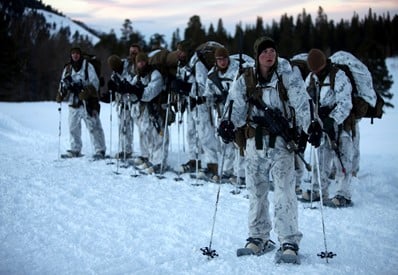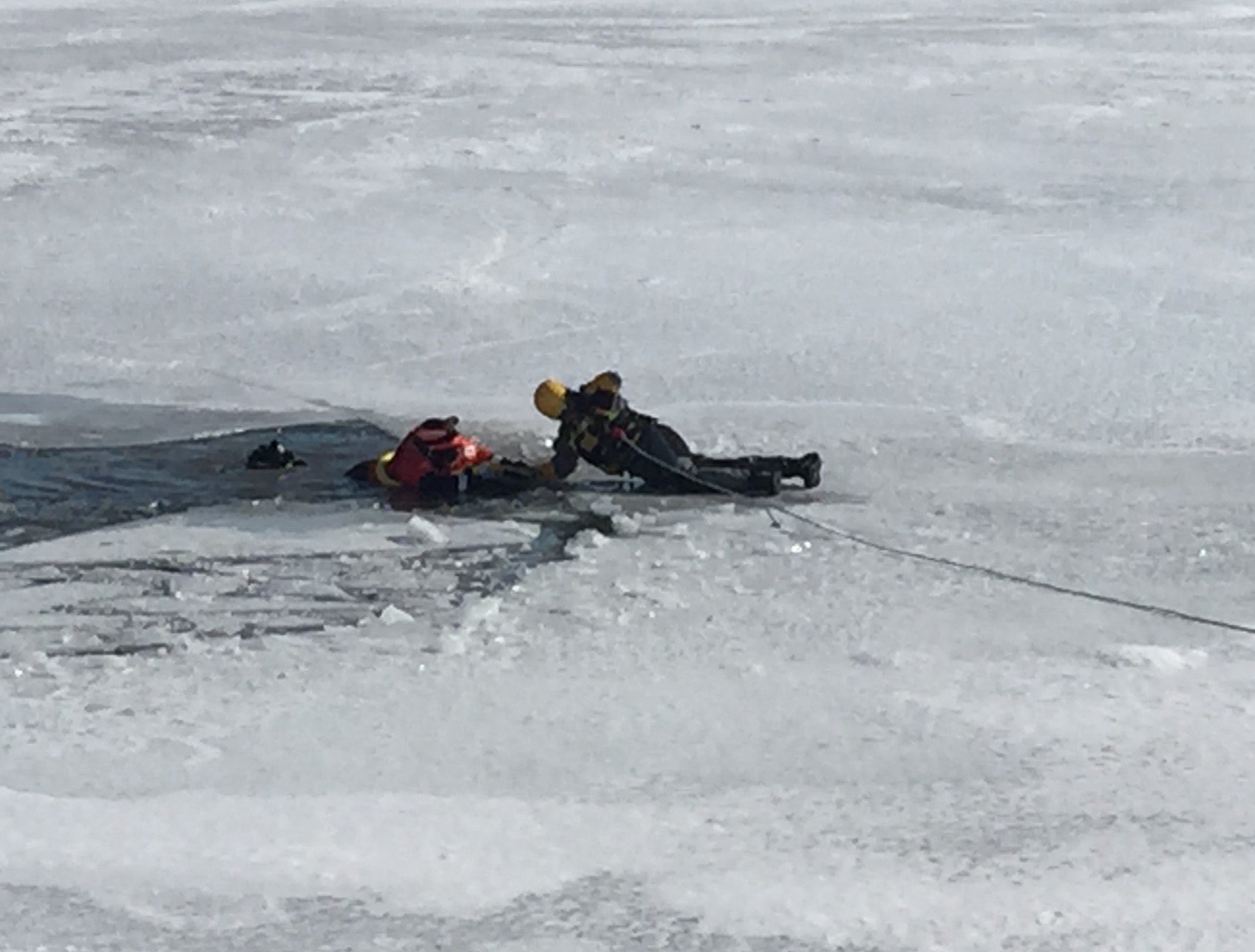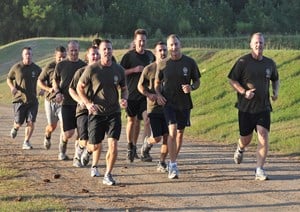
Considerations During Cold Weather Ops for LEO and TMPs
E. John Wipfler, III, MD, FACEP
Chair, Tactical Emergency Medicine Section
The law enforcement officer (LEO) and tactical medical providers (TMP) and others involved in high threat operations faces challenges in every direction when deployed. This article deals with cold weather and the injuries that can be produced. Proper preparation and a baseline knowledge of how to prevent cold injuries will do much to improve the likelihood of mission success.
As cooler weather approaches in most areas of our country, the author will list the key components of "dressing for success." As an emergency physician, Professor at the University of Illinois College of Medicine, Major (retired) with 14 years in the US Army Medical Corps, tactical physician for 28 years SWAT missions, and experienced mountain climber, Dr. Wipfler condenses his experience into recommendations on the necessary cold-weather gear and reasoning behind acquiring and using it. The tactical officer and other LEOs and TMPs when deployed do not have many options for avoiding cold weather when it is 20 degrees F on a windy night and the time for proper preparation has ended. It must be dealt with head-on. Get ready now. Even with global warming, many of us will face the challenge of cold weather operational deployments.
The Threat:
Cold weather kills. To make matters worse, cold weather can cause a deterioration of finger sensation (numbness), and whole-body cooling (hypothermia) that will dull the senses. Cold weather can slow the tactical thinking to the point where the unprepared tactical officer may either make a mistake and touch off a round at the wrong time or may be killed or injured due to slow mentation and delayed problem solving. Poor preparation in hot or cold weather extremes can lead to disaster. We as LEOs and TMPs cannot afford to be unprepared. A quick review of the basics and then we will list the key clothing and equipment to consider that will maintain body warmth and optimize our preparedness.
How cold kills:
Normal body temperature must be maintained within a very narrow range for the body’s chemistry to work efficiently. If the body is exposed to cold environments and fails to maintain a normal temperature of approximately 98.6 degrees F, these mechanisms will start shutting down and fail. Cold exposure may cause injury to individual parts of the body, such as the feet, hands, ears, or nose, or to the body as a whole. When the core body temperature falls, hypo (low) thermia (temperature) occurs. The definition of hypothermia is an inner core temperature of 95 degrees Fahrenheit or lower. Officers become combat ineffective and are a liability to the team. This must be prevented. Because heat always travels from a warmer place to a cooler place, the body tends to lose heat to the cooler environment when in certain climates. The body can also gain heat from the environment. Heat transfer can occur in five ways: Conduction, Convection, Evaporation, Radiation, and Respiration.
Conduction is the direct transfer of heat from a part of the body to a colder object by direct contact, such as when a warm hand touches cold metal of our weapons or icy pavement. Heat passes directly from the body to the colder object.
Convection occurs when body heat is transferred to circulating cooler air, such as when outside standing between several buildings on a windy day. Air moves across the body surface. A person standing outside in windy winter weather and wearing lightweight clothing is losing heat to the environment.
Evaporation is the conversion of any liquid to a gas, a process that requires energy, or heat. Evaporation is the natural mechanism by which sweating (perspiration) cools the body. Tactical officers with heavy gear and ballistic protection will easily sweat inside or while running or climbing into position. The problem occurs when they then are forced to stand or lay quietly in a fixed position for an hour or two and thus cool down. The temperature does not have to be below freezing for hypothermia to occur. If a SWAT officer becomes wet from sweating and then stands quietly, especially with non-wicking clothing like cotton T-shirts and underwear, it is possible for hypothermia to occur even when the temperature is 50°F (10°C). Cotton kills. Use appropriate sweat-wicking clothing as discussed later in this article.
Radiation is the transfer of heat by radiant energy, such as infrared heat waves from our human body. Radiant energy is a type of invisible light that transfers heat. The body can lose heat by radiation, such as when a person stands in a cold room. Heat can also be gained by radiation, for example, when a person stands by a fire or in bright sunlight. In cold weather, this is one of the leading causes of heat loss from the human body.
Respiration causes body heat to be lost as warm air in the lungs is exhaled into the atmosphere and cooler air is inhaled thus cooling the body. Common sense dictates that in colder freezing weather, we cool down much faster.
The professional who prepares ahead of time will take these 5 heat transfer mechanisms into account when preparing to “dress for success” for operational deployment in cold weather and obtain the proper clothing and gear.
What is hypothermia and how can I prevent it?
Hypothermia literally means “low temperature.” It is diagnosed when the core temperature of the body— the temperature of the heart, lungs, and vital organs— falls below 95°F (35°C). Normal body temperature is 98.6°F (37°C). The body can usually tolerate a drop in core temperature of a few degrees without serious harm, however the mental abilities will suffer and a LEO or TMP with early cooling of their entire body will not be as sharp and clear-thinking. This must be prevented.
Although extremely unusual in a normal SWAT callout, any tactical officer who becomes hypothermic with a body temperature below 95°F (35°C) will soon lose the ability to regulate their proper temperature and generate body heat. Progressive loss of body heat then continues unless the patient is moved to warmer conditions. To decrease heat loss from the skin, the body will send less blood to the skin, and constrict (narrow) blood vessels in the skin. This results in the characteristic appearance of blue lips and/or fingertips. If ‘cold’, the brain will sense this and will cause the body to create additional heat by shivering, which is the active contraction of many muscles to generate heat. If cold exposure worsens and these mechanisms are overwhelmed, many body functions begin to slow down. Eventually the functioning of key organs, such as the heart, is impaired. Untreated, this can lead to death.
Hypothermia can develop quickly, for example when an officer slips and falls down into a shallow ice-cold creek and remains on the frozen ground while crawling into position.

Mild hypothermia occurs when the core temperature is between 90°F and 95°F (32°C and 35°C). The officer is usually alert and shivering to generate more heat through muscular activity. The officer may jump up and down and stamp his or her feet. Pulse rate and respirations are usually rapid. The skin in light skinned individuals can be red, but may eventually appear pale, then cyanotic (blue). Poor coordination and memory loss follow, along with reduced or complete loss of sensation to touch, mood changes, and impaired judgment. The patient becomes less communicative, experiences joint or muscle stiffness, and has trouble speaking.
More severe hypothermia occurs when the core temperature is less than 90°F (32°C). Shivering stops and muscular activity decreases. At first, small, fine muscle activity such as coordinated finger motion ceases. Eventually, as the temperature falls further, all muscle activity stops.
As the core temperature drops toward 85°F (29°C), the casualty becomes lethargic, usually losing interest in continuing to fight the cold. The patient’s level of consciousness decreases; the confusion associated with hypothermia may cause the patient to remove his or her own clothes. Many wilderness hypothermia victims are found naked or with only underwear on. The muscles eventually become rigid, and the patient begins to appear stiff or rigid. If the temperature continues to fall to 80°F (27°C), vital signs slow; the pulse becomes weaker, and respirations become slow and shallow or become absent. Cardiac arrhythmias may occur as the blood pressure decreases or disappears. At a core temperature of less than 80°F (27°C), all cardiorespiratory activity may cease, pupillary reaction is slow, and the patient may appear dead. Patients may survive even severe hypothermia in the right circumstances if proper emergency measures are carried out. Fortunately, LEOs and TMPs rarely see this preventable condition.
Assessment and Stabilizing Care:
Cold emergencies may be discovered when the officer returns to the tactical operations center, during an evaluation at the rehabilitation station, or when a TMP or LEO notes the signs and symptoms in a fellow officer. Whether the patient is a SWAT officer in a rehabilitation station or a hostage who has been held in an unheated room during a long standoff, perfusion will be compromised based on the degree of cold the patient is experiencing. Your assessment of the patient’s skin will not be helpful in determining shock. Assume that shock is present and treat it appropriately. Bleeding may be difficult to find because of the slow-moving circulation and thick bulky clothing. If there is a mechanism of injury that suggests the potential for bleeding, look for it.
When assessing the patient’s airway, take into account the physiologic changes that occur as a result of hypothermia. Ensure that the patient has an adequate airway and is breathing. If your patient’s breathing is slow or shallow, ventilation with a bag-mask device may be necessary. If warmed and humidified oxygen is available, use it.
Always make sure to handle the patient gently so that you do not cause any pain or further injury to the skin. Do not massage the extremities. Do not allow the patient to eat if they are seriously ill and lethargic. Avoid any stimulants such as coffee, tea, or cola; or to smoke or chew tobacco if they have an altered mental status due to hypothermia.
Even mild degrees of hypothermia can have serious consequences and complications, including cardiac arrhythmia and blood-clotting abnormalities. Therefore, all patients with hypothermia require rapid evaluation and evacuation and transport for further advanced treatment. Assess the scene for the safest way to evacuate your patient from the cold environment. Work quickly, safely, and gently. Rough handling of a hypothermic patient may cause a cold, slow, weak heart to fibrillate and the patient to lose any pulse that may have existed. If a casualty has frostbite or extremity pain, prevent further damage to the feet and do not allow the patient who has suspected frostbite on the toes or feet to walk.
If transportation is delayed, protect the patient from further heat loss. Move the patient out of the wind and away from contact with any object that will conduct heat away from the body. Remember that a large amount of body heat is lost around the head and neck. Remove any wet clothing, and place dry blankets over and under the patient. Use of ‘survival blankets’ (mylar, shiny silver thin plastic sheets) are very helpful and will help the casualty. Medical care of the patient during transport is directed at preventing further heat loss and rewarming. Remove wet clothing and prevent further heat loss by covering the head and body. If the patient is conscious, alert, and shivering, place wrapped heat packs in the groin, axillary, and cervical regions, being careful not to cause burns. Remember to handle the patient gently to decrease the risk of ventricular fibrillation. Follow your local protocols for treating moderate or severe hypothermia. If the patient does not have a pulse or is not breathing, provide resuscitation per local protocols.
Local Cold Injuries
Most injuries from the cold are localized to the extremities or exposed parts of the body, such as the tips of the ears, nose, upper cheek, and tips of the fingers or toes. Local freezing injuries fall under the general heading of frostbite. Frostbite is an ischemic injury that is classified as superficial or deep depending on whether tissue loss occurs.
A very mild and early form of frostbite is called frostnip, which comes on slowly and generally is not painful, so the victim tends to be unaware of its occurrence. Frostnip is easily treated by placing a warm hand firmly over the chilled nose or ear, or, when the fingers are frostnipped, by placing the fingers into the armpits. The return of warmth to a frostnipped area is usually signaled by some redness and tingling.
Deeper degrees of frostbite involve freezing of tissues and can occur only in freezing weather. Individual cells in the skin and body are composed chiefly of water, so when they are subjected to low enough temperatures, the water within them turns into ice crystals, which can damage or destroy the cells.
Trench foot involves a process like frostbite but can occur at temperatures as high as 60°F (16°C). It is caused by prolonged exposure to cool, wet conditions. The mechanism of injury can be explained by conduction: Wet feet lose heat 25 times faster than dry feet. Vasoconstriction and an ischemic cascade similar to that seen in frostbite then set in. Prevention—keeping the feet dry and warm—is the best treatment. Carry multiple pairs of clean, dry socks and, whenever your feet become wet, change your socks, and dry your boots as well as possible. Fortunately, this cold injury is rare in SWAT and LEOs, but common in war and extended operational deployments.
Superficial Frostbite
The most common symptom of frostbite is an altered sensation: numbness, tingling, or burning. The skin typically appears white and waxy. Because it is frozen, the skin is firm to palpation, but the underlying tissues remain soft. Once thawing occurs, the injured area turns blue, called cyanotic, and the patient experiences a hot, stinging sensation. Edema occurs in the frostbitten area. Dull or throbbing pain may persist for days or weeks after the injury.
The care of superficial frostbite differs significantly from that of deep frostbite, so it is very important to distinguish between the two. Usually, it is difficult to determine the depth of the injury when you first see it— even a shallow frostbite injury can appear to be frozen solid. If the tissues beneath the skin are soft when you press down on the skin surface, the frostbite is probably superficial. If not, or if there is any doubt, treat the injury as deep frostbite.
Mild cold injuries are generally managed by a combination of dressing properly, rest, food, and limiting exposure to the cold. Once you have determined that the patient has superficial frostbite, get the patient out of the cold. Take the patient someplace warm indoors or into a heated ambulance so the body can stop hoarding its warm blood in the core and send some to the periphery where it is urgently needed. Wrap the patient in blankets and wrap the patient’s head and neck in warm clothing or blankets. Have the patient lie down or sit in a warm environment and encourage shivering to increase the body temperature. Give this casualty hot beverages, but avoid coffee, tea, chocolate, or caffeinated drinks. Rewarm the injured part with body heat if the frostbite appears to be superficial. If an ear, nose, or foot is frostbitten, apply firm, steady pressure against the area with a warm hand. If a hand is frostbitten, have the patient insert the hand into the armpit and hold it there without moving. Do not try to rewarm a frostbitten part with radiant or dry heat as the skin is numb and cannot accurately detect when the heat is too damaging to the skin. Do not rub or massage the frostbitten area; massage will cause further damage to injured tissues. If blisters form, do not puncture them but rather cover them with a dry, sterile dressing and protect the area from further injury. Rapidly evacuate the patient to transport and transport the patient to the hospital with the injured area elevated and protected from the cold.
Deep Frostbite
Deep frostbite usually involves the hands or the feet and rarely involves exposed ears and noses. A frozen extremity looks white, yellow-white, or mottled blue-white, and it is hard and cold and lacks sensation. The major tissue damage occurs not from the freezing of the tissues, but rather when the tissues thaw out, particularly if thawing occurs gradually. When tissues thaw slowly, partial refreezing of melted water may occur. Because these new ice crystals tend to be much larger than those formed during the original freeze, they cause even greater tissue damage. As thawing occurs, the injured area turns purple and becomes excruciatingly painful as the frozen nerve endings re-awaken. Gangrene (permanent cell death) may set in within a few days, requiring possible amputation of all or part of the injured toe or finger or larger body part.
If there is no chance that the frostbitten extremity will refreeze during evacuation or transport, then initiate steps to thaw the extremity as soon as possible in water 104 degrees. However, if severe conditions require the patient with frostbitten feet to walk during evacuation, or if there is a chance of exposure to freezing temperatures during evacuation, then do not attempt to rewarm the frostbitten extremity. It is extremely important to not thaw the frostbite areas if there is any chance of a refreezing injury during evacuation or transportation. Once the patient is in the raid vehicle or ambulance, the patient’s injured extremity should be padded to protect the tissues from further trauma and kept away from the heater or any other sources of dry heat. Do not massage the extremity. The cells are full of ice crystals and massaging the extremity will cause the ice crystals to damage tissue cells.
If the evacuation or transport will be delayed, contact medical control to discuss field rewarming. If you are permitted, rewarm the injured extremity before and, if possible, during transport. To do so, you will need a warm water bath—a large, clean container in which the extremity can be immersed without touching the container’s side or bottom. Water should be heated in a second container and then stirred into the water bath until the temperature of the bath is between 104°F (40°C) and 108°F (42°C). While the water is heating, an intravenous analgesia such as fentanyl or morphine may be administered by an ALS (advanced life support)-level provider if local protocols allow. The patient will experience very severe pain as the limb thaws, so mitigating the pain will make the patient more comfortable.
When the water bath has reached the appropriate temperature, gently immerse the injured extremity. Keep a thermometer in the water. When the water temperature falls below 104°F (40°C), temporarily remove the injured extremity from the bath while you add more hot water to the container. Stir the water around and keep adding more hot water until the bath is again in the appropriate temperature range; then re-immerse the injured extremity.
The rewarming procedure typically takes 15 to 30 minutes. It is complete when the frozen area is warm to the touch and is deep red or bluish (and remains red when you remove the limb from the water bath). While rewarming is in progress, the patient should be kept warm, preferably indoors, with insulated clothing and blankets. Do not permit the patient to smoke or to drink caffeinated beverages, because nicotine and caffeine cause vasoconstriction, which decreases the blood flow to the injured area. Once rewarming is complete, clean and dry the injured extremity and apply sterile dressings very gently. Use sterile gauze to separate frostbitten fingers and toes. Rapidly transport the patient to the hospital.
That all sounds bad. How do we prevent cold injuries?
Here is a list of the gear that tactical officers should obtain and be prepared to use during cold weather operations:
A) Clothing and Uniform
There are four layers all together that may be used in cold weather ops:
1) Inner layer – underwear – sweat-wicking type, like Thermax or polyethylene. Do not use cotton. Long underwear (pants and long-sleeved shirts) should be thicker if extreme cold conditions will be faced.
2) Pile or equivalent jacket and pants – polyethylene or Thermax, that will draw away sweat even further, and will provide a layer of warm air.
3) Coat and pants that are light and fluffy – such as goose down or modern synthetic feather equivalent (Coreloft, Primaloft, others) – this will create dead-space and a protective layer of warm air between the inner body and the outer wind- and water-resistant coat.
4) Gortex or other wind-proof and water-resistant coat and pants, which will block wind and rain and snow.
B) Don’t forget your head, neck, and hands.
Up to one third of your blood flow is to your head and neck, and this is a common way for officers to cool down rapidly.
- Hat: You should own a thin socking hat that will fit underneath your helmet comfortably. If deployed in conditions without a helmet, then bring a thicker hat, one that preferably has a Gortex outer shell to block wind and rain and snow.
- Neck gaiter: This is a very valuable and worthwhile piece of gear that many officers to not have. Get a soft Thermax or pile material neck gaiter (tube-like, fits around the neck and lower part of face). This is a huge asset. It may also serve to hide one’s identity if needed, (instead of a balaclava) as it hides the lower face / mouth area. Note that many Nomex or thins balaclavas will provide some protection but not nearly as much as a dedicated thick, soft gaiter.
- Gloves: Many tactical officers use a thin leather glove or man-made nylon-type glove. These unfortunately do not provide much warmth but do have the advantage of allowing some dexterity and sensation that will allow proper ‘feel’ of the weapon and trigger. One worthwhile consideration is to purchase an extra-large over-sized mitten-style of glove which allows the officer to insert their hand inside with the above thin work-glove on. A hot pack can be inserted as well into each mitten that will provide a welcome heat source on an extra-cold day.
- Hot packs – there are several manufacturers that make small hand and feet-sized “air-activated hot packs” that provide good warmth for several hours. Just the ticket for keeping your trigger finger warm and ready for action. Some of the hot packs manufactured can get quite hot and may cause minor skin burns if held in direct contact with thin skin for prolonged time, but mostly they work excellent, and can be kept in one’s hand or glove. These are single-use items that are disposed of after use. Other styles of hand-warmers are powered by lighter fluid and may work well but are complicated by hassle and odor and fire hazards. Newer battery-powered socks and gloves are improving and may be worthwhile considering for certain conditions.
- Goggles – if wind and snow or extremely cold weather are expected, consider acquiring and using a nice pair of ski goggles that have a double-walled two-layer eye lens system, which have been treated with a “de-fog” anti-fog cloth or chemical on the inside. Fogging of glasses / goggles is a bad problem especially if it occurs during entry or other critical time. Consider using de-fogging agents and test these before real-world missions. Train hard and get to know your gear and be sure to test it to ensure that your vision is not compromised.
- Foot protection – the normal leather boots commonly worn by SWAT officers work well in nice weather, but when cold rainy or snowy conditions occur, then the best solution is to obtain a style of boots that is sure-footed, insulated, waterproof, and will allow extra room for two pair of socks including thick cold-weather socks. Consider buying the boots a size larger than normal which will allow adding one air-activated hot pack into the toe area of each boot. Also consider buying and using a pair of electric battery-powered socks that have been tested and proven to work. Additional considerations would be small ice-grabber soles made for slippery ice conditions, and in steep or deep snow consider crampons (steel spikes on feet) or snowshoes.
- Overcoat – Most tactical officers who live year-round in the northern part of our country will have a coat that fits them when they are on regular patrol. However, if a full-equipped tactical officer has on their helmet, Level III ballistic vest, M-4 magazines, gas mask, IFAK, then it takes an extra-large overcoat to properly fit over this. Therefore, consider your deployment options and consider buying a Gortex overcoat or better yet, a parka-style insulated coat with hood that is extra-large and will wrap around your entire gear assembly. At the minimum, a 30-dollar poncho will be necessary to help stay dry and warmer.
- Frozen water - Items for cold weather operations on a frozen lake or river – Freezing weather will turn lakes, ponds, and rivers into flat frozen sheets of ice. If mission requirements dictate that tactical officers may travel over this ice, then this adds an element of danger that must be addressed. The best option is to simply not walk or drive on ice, especially if it is a river with moving water underneath. Two items that should be considered are life-preservers (flotation devices) and self-rescue ice picks. There are relatively small inflatable water flotation devices that can be worn and activated with a CO2 cartridge if a catastrophe occurs and a heavily tactical officer breaks through ice into the water. Although not inexpensive, this preplanning and preparation (and realistic pre-testing) will add an element of safety. The other item is a simple set of “ice picks” that are simply worn around the neck or upper chest of the wearer that will allow an officer to grasp one pick in each hand, and if fallen into water up to their upper chest, will allow the officer to drive these into the ice and use their own muscles and maneuvering to pull themselves out of the water onto the ice. Again, this is a rare occurrence, and it will likely necessitate that the officer dump their weapons and tactical vest and belt gear in order to rapidly self-extricate over the lip of ice from the deadly situation.
Summary
Cold weather operations present a formidable obstacle for LEOs, TMPs, and others involved in operational deployments. Knowledge of how to prevent cold injuries is important for all team members and tactical medicine elements. Know the symptoms of early hypothermia and watch out for this in your fellow team members. Stay warm. Get good quality winter gear and train and prepare to meet this challenge. Several important and unique aspects of cold injuries have been presented and will often be needed. Some additional gear suggestions should be considered including proper head and neck protection, boot, and overcoat considerations, as well as gear for operations over frozen water. With foresight and proper planning, cold weather should not be feared, only respected.
- John Wipfler, III MD, FACEP
Chair, ACEP Section of Tactical Emergency Medicine
Co-Chair, Tactical Medicine Committee, ITOA (reprinted with permission of ITOA News)
Professor, University of Illinois College of Medicine
Attending Emergency Physician, OSF Saint Francis Medical Center
Peoria, Illinois



